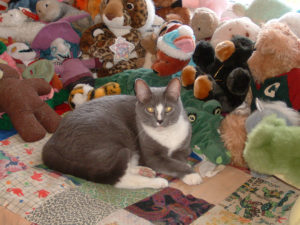Facing the loss of a pet brings so many challenges to the people going through that experience – but the longer I work in hospice and end-of-life care, the more I realize that one of the most difficult parts of this loss for many people is just the fact that we live in a culture that doesn’t give us a guideline for how to navigate such a tragedy.
While everyone experiences grief differently, for most forms of loss there are standard procedures and behaviors that we can look to, that help shape our reactions and let us know that what we’re going through is normal and accepted. We cry, we hold funerals, we send flowers, we partake in rituals that are given to us by our faith, our families, and our communities. But very few of those resources exist for the loss of a pet, and so often people don’t know quite how to behave or react in the face of that pain.
So many times I hear clients ask me, ‘Is this normal?’ or ‘Does everybody do this?’ Or, even more tragically, they hesitate to ask for things that may comfort them or aid them in their grieving process because they are afraid that it will seem strange or silly. And I want, more than anything, to help dispel that fear and reassure everyone reading this that, whatever shape it takes, your path through loss is the right one for you.
First, grief is universal in the face of loss. Different people may express it in different ways – some people cry, some are quiet, some tell stories; some people need company and others need to be alone; some need to take action and others need time for introspection – but those are all reactions to the pain and heartache of losing a living being that you shared your life with. It is entirely normal to hurt, to feel sorrow, and to mourn that loss. You are not alone or unusual in loving, caring, or hurting, and there is nothing wrong with having such love and compassion in your life that you grieve when that part of your family is no longer with you.
Secondly, for all that grief is universal, mourning and memorializing are incredibly unique and personal. We all bring our own beliefs, history, and experiences with us to every relationship in our life, and to the passings that happen when those relationships end. As tragic as death is, every loss is in some way a celebration of the bond shared between the being that passes and the person or people who loved them, and a final chance to act to honor that bond.
If there is something that feels like an appropriate way to honor your pet’s passing, or that would comfort you in the face of that loss, please tell your veterinarian. I promise you, it is not silly, you will not startle or offend us, and if anything we will be grateful for the trust you are showing us and the chance we have to help you and your beloved pet. Whether it’s making them a favorite meal first, singing a favorite song or reading a prayer or poem, having pictures of family who can’t be present nearby, saving a lock of fur, sending them with a favorite toy, treat, or symbol of faith after they have passed, or any other act that may feel right to you, please do tell us. This is part of why I describe what we do as end-of-life care, and not just euthanasia – there is so much more to saying goodbye to a beloved pet than just the act of helping them pass, and both you and your pet deserve to be cared for with compassion, respect, and kindness throughout that experience.
I’ve said before that there is no one right or wrong way to grieve, and that holds true for the process of letting go. It seems paradoxical to say both that grieving is normal and that each person’s grief process is different and special, yet both are true, and worry and self-consciousness have no place interfering in such a challenging time. Your bond with your pet is unique, and it is our job (and our honor) as hospice veterinarians and caretakers of that bond to help both you and your pet navigate this final chapter of their life in the best way possible.



 share memories, pictures, and stories here in honor of our beloved pets.
share memories, pictures, and stories here in honor of our beloved pets. resence in our home. For Henry’s sake, the decision had to be made and we sought out a provider who would help us make sure that Henry’s passing was done in a way that eliminated the stress of a trip to the vet’s office. Our decision to allow Henry to pass in an environment he loved was a no brainer. A few months have passed since Henry’s passing and it has been difficult getting used to life without Henry. His absence in our home and in our individual and collective lives cannot be described. Our continued grief is only manageable because of the genuine compassion and kind words of Dr. Becky Schoenberg and in knowing that, thanks to Dr. Schoenberg, Henry’s last moments were spent in a place that he loved, with people that he loved, and with people who loved him until the end of his life and beyond. Our grief has not allowed us to think of rescuing another dog yet, but if/when we do and it is time for that pet to make his trip to rainbow bridge, I wouldn’t want anyone else there with us other than Dr. Schoenberg. Bringing Dr. Schoenberg in to our lives and in to our home was perhaps one of the kindest things we’ve ever done for our Henry.
resence in our home. For Henry’s sake, the decision had to be made and we sought out a provider who would help us make sure that Henry’s passing was done in a way that eliminated the stress of a trip to the vet’s office. Our decision to allow Henry to pass in an environment he loved was a no brainer. A few months have passed since Henry’s passing and it has been difficult getting used to life without Henry. His absence in our home and in our individual and collective lives cannot be described. Our continued grief is only manageable because of the genuine compassion and kind words of Dr. Becky Schoenberg and in knowing that, thanks to Dr. Schoenberg, Henry’s last moments were spent in a place that he loved, with people that he loved, and with people who loved him until the end of his life and beyond. Our grief has not allowed us to think of rescuing another dog yet, but if/when we do and it is time for that pet to make his trip to rainbow bridge, I wouldn’t want anyone else there with us other than Dr. Schoenberg. Bringing Dr. Schoenberg in to our lives and in to our home was perhaps one of the kindest things we’ve ever done for our Henry.